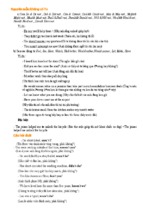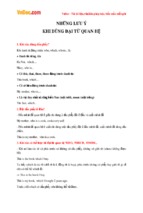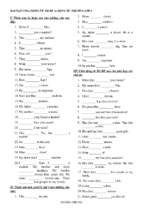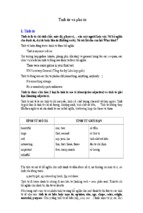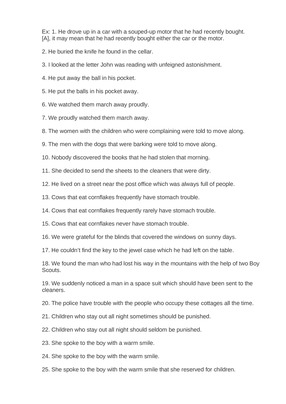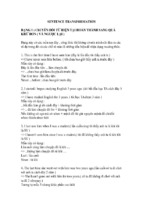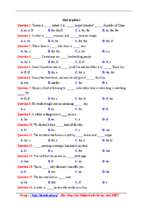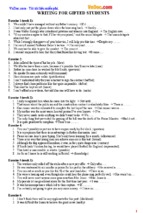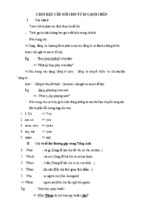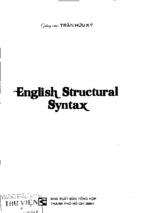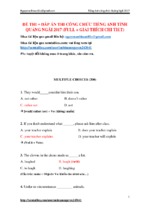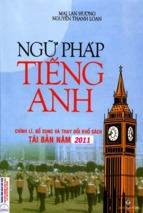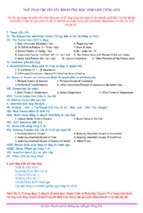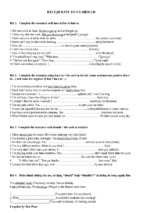Oxford English Grammar Course
advanced-level teachers’ notes
INTRODUCTION TO THE BOOK
The purpose of the Oxford English Grammar Course
OEGC is intended to help those students who want or need to make their English more
grammatically correct. Our aim is not necessarily to encourage teachers and students to
do more grammar – there are many other things that have to be fitted into a language
programme. Our purpose is simply to make this important component of a course as
effective as possible, so that students can learn the grammar that they need successfully
and without wasting time.
The explanations and exercises in a book of this kind will not of course guarantee faultless
speech or writing by learners – nothing will, and in any case few foreign-language learners
need to aim at a native-speaker level of accuracy. But such work can help to make students
more aware of the correct formation and use of key structures, and thus usefully reduce the
number of errors in their production.
Using the book
Like any grammar practice book, OEGC Advanced can be used in various ways. Most
teachers will probably wish to use it selectively, working on broad topics (e.g. modal verbs)
or particular points (e.g. the expression of certainty) that classes or individuals need to learn
or revise. Some language specialists, however, may find it useful to work through the whole
book. A good deal of the work can be done for homework, thus freeing up valuable class
time for other activities. The book is also suitable for self-study.
Teachers will have their own ways of using this kind of material in class, and we would not
wish to suggest any kind of step-by-step procedure. We do, however, suggest that, where
possible, teachers translate the grammar explanations into the students’ mother tongue.
(There is no basis in theory or research for the old dogma that the mother tongue should
be avoided at all costs in language teaching. There are times when it is extremely helpful,
and grammar explanation is one of them.) We also suggest that, as far as possible, teachers
avoid a turn-taking oral approach to exercises (‘You do number 1, you do number 2, …’).
Students learn what they do, and if what they do is mostly listening to other students,
that is what they will learn – scarcely a high-priority skill! The more they can do grammar
exercises through group work, or other activity types which enable them all to work at the
same time, the more practice each individual will get.
The answer key can be used by students to check whether they have understood the
material correctly. Students being what they are, some will no doubt ‘cheat’ by using the
key to do the exercises; they will learn very little English by doing so.
Content and level
OEGC Advanced spans quite a wide range. It includes a good deal of revision work on
points which will have been studied earlier, but which may still cause problems to some
learners. At the other end of the scale, it covers some topics which may only be valuable
for English specialists who need a high-level command of the structures of the language,
particularly those of formal written English. For such students, additional notes on matters
of detail (printed on a grey background) are provided where this may be useful.
At this level, grammar and skills come closer together, as the aspects of grammar that are
involved in the structuring of written and spoken texts assume increasing importance.
Oxford English Grammar Course • Advanced © Michael Swan and Catherine Walter 2012
OEGC Advanced has a separate 50-page section (‘Part 2’) which focuses particularly on
grammar beyond the sentence.
Illustrations
Structures are often illustrated in real-life contexts such as short texts, quotations,
advertisements or cartoons. These are generally intended as undemanding reading matter
for students, which will help to introduce the structures and perhaps fix them in students’
minds. They are not necessarily meant as exercise material. They can of course be exploited
in this way if teachers wish, but we think there is an important place in language work for
‘no-hassle’ reading.
Cartoons can be problematic, especially with students from backgrounds with different
approaches to humour from European cultures: the jokes may sometimes need explanation
by the teacher, and may occasionally simply not get across at all. However, cartoon
captions can also constitute very direct and memorable illustrations of one or other point of
grammar, and we feel they are well worth including for this reason.
The ‘Pronunciation for grammar’ CD-ROM
Grammar and pronunciation have a good deal to do with each other. For many students,
the main problem with English pronunciation is not productive but receptive: they
can be understood more or less well, but they may have great difficulty themselves in
understanding natural speech. This is largely due to the character of English stress and
rhythm: unstressed syllables are pronounced quickly and unclearly, and frequently with
a reduced pronunciation. These syllables can be hard for many students to perceive,
especially if their languages do not have a similar phonetic structure. These unstressed
syllables are mostly grammatical elements: auxiliary verbs, articles, prepositions and
conjunctions. Grammatical endings, too, can be hard for non-native hearers to catch:
the difference between, for example, stop, stops and stopped is not easy to perceive for a
student whose language does not have final consonant clusters.
The ‘Pronunciation for grammar’ CD-ROM provides a large number of exercises linked to
the various grammatical topics dealt with in the book. Their purpose is to sensitise students
to these unstressed grammatical elements, so that they learn to perceive them more easily
(as well as practising their correct production). The CD-ROM exercises also help students
to distinguish the intonation of questions and statements, and to perceive and produce
typical English patterns of stress and rhythm.
Learners of English today are likely to use the language in a variety of international
contexts. We have felt it useful, therefore, to include some recordings which introduce
students not only to different native-speaker accents (standard British, Scottish and US
American), but also to examples of non-native (Spanish, Indian, Chinese, Japanese and
Arabic) pronunciation.
THE LESSON-BY-LESSON NOTES
‘Possible further activities’
OEGC Advanced already provides a good deal of practice material, both in the individual
lessons and in the ‘More Practice’ pages that follow the various topic Sections. However,
teachers will often wish to supplement the printed exercises with additional practice,
particularly with the kind of personalised communicative activities that can help to bridge
the gap between controlled classroom work and accurate spontaneous use of a structure.
These Teachers’ Notes contain some lesson-by-lesson suggestions for practice of this kind,
as well as suggestions for out-of-class work. Teachers will certainly be able to add further
activities based on their own thinking and experience. They will also find valuable ideas in
the various books that have been written specifically to offer material for grammar practice
– for instance Penny Ur’s Grammar Practice Activities (Cambridge University Press 2009).
Oxford English Grammar Course • Advanced © Michael Swan and Catherine Walter 2012
Some of the exercises suggested in the following notes will need a little preliminary work
by the teacher; others can be done with no preparation. Many of them involve pair work,
group work or movement in the classroom. This kind of work is essential if students are to
get enough practice to carry over what they have learnt into fluent production; nobody
gets very much practice if students speak one at a time in turn. However, students from
some educational cultures may not be used to this element of relative freedom, especially
where exercises involve moving around in the classroom. They may need to be introduced
to this kind of work slowly, starting with simple short activities in pairs.
Some exercises involve mime (which can provide very effective cues for speech), or other
kinds of low-level dramatisation. Some students enjoy this kind of activity; others may be
self-conscious about having the spotlight on themselves, so to speak; or they may simply
get impatient with activities involving acting or miming, preferring real communication to
role communication. Other exercise types that may be unfamiliar and meet with resistance
for cultural reasons are those that involve exchanging personal information with other
students or the teacher; and even where there is no cultural barrier, not all students like
talking about themselves in public. It’s important to make sure that a class is offered a
balanced diet that offers something for everybody, and to avoid pressurising students who
are really unwilling to participate in one or other kind of activity.
Where individuals or groups are asked to produce something (for example a mime, a
dramatisation or a mini-report) for the rest of the class, it is good to start with confident
students, but one should avoid starting with the best (this can discourage the others).
Note that some activity types are useful for practising more than one point of grammar,
so there is occasional repetition in what follows. Many of the activities described here are
suitable for students at more than one level, and will also be found, with minor differences,
in the Teachers’ Notes for lower levels of the Oxford English Grammar Course.
Some exercises invite students to use an internet search engine such as Google for
examples of the structures being practised. These exercises will naturally be done out of
class; students will report back on their findings in the next lesson. It may be necessary to
remind students to enclose the search items in double quotation marks: “…”. Note that an
internet search can sometimes be made difficult or impossible by the existence of a current
popular reference containing the relevant structure which swamps the net. At the time of
writing, for instance, if one searches for sentences beginning “The only time I …”, most of
the hits are identical quotations from the same song. It is also worth bearing in mind that
English-language internet material will be in British, American and other varieties of English,
and will include non-standard usage as well as postings by non-native speakers whose
English may contain errors.
‘Language notes’
The following material also includes ‘language notes’ for some of the lessons. In these, we
mention typical problems that students may have with certain structures, often because
of cross-language differences. We hope that these notes may be useful to less experienced
teachers, especially those who are working with students with whose languages they are
not familiar. More detailed information about the problems which speakers of particular
languages may have with English can be found in Learner English, edited by Michael Swan
and Bernard Smith (Cambridge University Press 2001).
Oxford English Grammar Course • Advanced © Michael Swan and Catherine Walter 2012
LESSON-BY-LESSON NOTES
Section 1 basic sentence types
pages 2–3
language notes
The rules for question construction revised here are those that are followed in formal
written and spoken English. It’s worth pointing out to students (if they haven’t already
realised) that informal speech often follows rather different rules. Declarative questions (see
pages 286–288) have the same word order as statements:
You’re coming on Friday evening, right?
And fronting (see page 257) may bring the subject, object or another part of the sentence
before the verb:
That kid – is he pretending to be ill again?
Some elementary mistakes may still occur at this level. Look out for problems of word order
with long subjects, for omission of do, and for the use of do with question-word subjects:
*Where all those people are going?
*What means ‘out of her mind’?
*Which of these phones does work best?
Informal questions ending in prepositions are difficult for most students at the early stages,
since few languages have a similar structure. Some advanced students who have learnt
their English mainly from written models may still have problems.
*About what did she talk?
*For whom are you waiting?
The CD-ROM exercises for this Section practise perceiving and producing weak forms of
auxiliaries in questions, and distinguishing question and statement intonation.
possible further activities
Personalisation: children’s questions If students need more practice in question formation,
they could do Exercise 5 on page 15. This could be followed by a personalisation activity in
which students say or write some of the questions that they asked when they were small
children. Alternatively, get them to invent questions (perhaps five each) that they think
small children might ask.
Dialogues: two-word questions Get students into pairs, and give each pair one of the
following questions. They have two minutes to prepare a mini-dialogue containing the
question; then students deliver their dialogues to the class.
Who for? Who with? Who to? Who from? What about? What for? What with?
What in? Where to? Where from?
Texting role-play Divide students into pairs or groups. In each pair/group, one takes on the
personality of someone famous (living or dead), but does not tell the other(s) who he/she
is. The others text or email the ‘famous people’ (out of class), trying to find out who they are
by asking as many questions as they can about them (but not asking directly about their
identity).
Testing your memory Get each student in turn to say ‘Hi’ to one other student (not his/her
neighbour). Then the students test your memory, like this:
‘Who did Maria say ‘Hi’ to?’ ‘Who said ‘Hi’ to Maria?’
An asterisk (*) indicates an incorrect form or use.
➔ Section 1 continues
Oxford English Grammar Course • Advanced © Michael Swan and Catherine Walter 2012
page 4
language notes
Mistakes with basic negative structures are unusual at this level. Look out for occasional
instances of multiple negation from students whose mother tongues have this feature:
*I didn’t say nothing to nobody.
*We didn’t hardly have time to eat lunch.
It’s best not to tell students that this structure is ‘illogical’. It’s the regular pattern in a
number of languages, was correct in Old English, and is still normal and systematic in many
dialects of English.
possible further activities
‘Hardly’: confessions Get students to say or write three or more things that they can
hardly do.
‘Hardly’: mime Mime being hardly able to do something (e.g. see, speak, walk, hear, stand
up, sing). The class tell you what you can hardly do. Alternatively, get volunteers to do the
mimes.
page 5
language notes
The distinction between not and no can be tricky. The explanation on page 5 should make
things clear if necessary. However, there are cases where the same thing can be said with
either structure:
There was not time. / There was no time.
and this can confuse students who may suppose that no in the second example goes with
the verb (like not) rather than with the noun.
possible further activities
Vocabulary expansion: ‘no’ or ‘not’? Teach/revise a number of nouns and adjectives (for
example, the ones listed below):
success successful respect respectful impression impressive
encouragement
encouraging enjoyment enjoyable creativity creative selection selective
confusion confusing profit profitable doubt doubtful
Then say the words, mixing up the order; students have to repeat them, putting either no or
not before them. Like this:
‘money’ – ‘no money’ ‘ready’ – ‘not ready’ ‘fast’ – ‘not fast’
‘bread’ – ‘no bread’ ‘today’ – ‘not today’ ‘tickets’ – ‘no tickets’
Notices Students write notices (one each) for the class/city/country, using the structure
NO …ING, to stop people doing things they disapprove of.
pages 6–7
language notes
Some students find the structure of negative questions tricky, even at advanced level.
*Why she didn’t phone?
*Is not the post office open today?
Negative questions can have two contrasting functions: to confirm a negative belief:
Isn’t Peter here yet? Maybe he’s missed the train.
An asterisk (*) indicates an incorrect form or use.
➔ Section 1 continues
Oxford English Grammar Course • Advanced © Michael Swan and Catherine Walter 2012
or to confirm a positive belief:
Don’t you speak German? Yes, I thought you did. Maybe you can translate this for me.
However, this doesn’t usually seem to cause confusion.
In some languages, answers to negative questions use the equivalent of Yes or No in order
to confirm or disconfirm the questioner’s expectation. This can lead to mistakes:
‘Aren’t you working tomorrow’ *’Yes, I’m not.’
‘Don’t you take sugar?’ *No, I do.’
In English, the choice depends on the grammar of the answer, not the meaning (see the
explanation on page 6).
Note that negative questions are not used to make polite requests. Compare:
You can’t help me for a moment, can you? (Polite request)
Can’t you help me? (Complaint: = ‘Why can’t you help me?’)
A CD-ROM exercise helps students to perceive the unstressed syllables that distinguish
negative questions from ordinary questions.
possible further activities
Visitor from space: confirming negative beliefs Tell the class to imagine that you are a
visitor from a distant planet where everything is different! They ask negative questions to
check that everything really is different. Like this:
‘Don’t you have electricity?’ ‘No, we don’t.’
‘Don’t you eat?’ ‘No, we don’t.’
‘Don’t you fall in love?’ ‘Yes, we do.’
pages 8–9
language notes
Transferred negation is common with verbs like think, believe, suppose etc, especially in an
informal style. Instead of putting not with the negative belief that is being talked about, we
often move not to the verb of thinking, believing etc. So to report a belief that somebody is
not at home, we are more likely to say ‘I don’t think she’s at home’ than ‘I think she’s not at
home’, though in most cases most structures are possible. With hope, however, transferred
negation is not used.
I hope they don’t attack. (not *I don’t hope they attack.)
Notice the common use of a present tense after hope to refer to the future.
possible further activities
Unfavourite activities Students complete the following sentence in three or more ways:
I never want to … again as long as I live.
pages 10–11
language notes
Imperatives (the use of base forms to give instructions, advice etc) should present few
problems at this level, though one or two points of word order may need attention. Note
the possibility of using do with be in imperatives.
Some students may still not realise that imperatives are not generally used to ask for things
politely. Native English-speakers may be offended by ‘requests’ beginning with ‘Please’ and
an imperative. ‘Please tell me …’, for example, is a command, not a request.
An asterisk (*) indicates an incorrect form or use.
➔ Section 1 continues
Oxford English Grammar Course • Advanced © Michael Swan and Catherine Walter 2012
possible further activities
Misleading advice for foreigners Students work in groups to produce five or more pieces
of misleading advice for foreigners visiting their country, or the country where they are
studying. Each piece of advice should begin ‘Always …’ or ‘Never …’. For example:
Always shake hands with everybody when you get on a bus.
Never tip a taxi-driver.
When they are ready, they read out their advice in turn.
page 12
language notes
In some languages, first person plural forms can be used to make suggestions, in the same
contexts as English Let’s. This can lead to mistakes or inappropriate utterances:
*Now, we have lunch.
Students may take time to get used to the different uses of the structure, and the
differences in formality between the various negative forms. Make sure they also realise
that the full form let us is very formal and uncommon.
possible further activities
Internet Ask students to look for interesting suggestions on the internet beginning “Let’s
all …”. Tell them to write down three that they would like to follow, and three that they
would not.
page 13
language notes
The word order of exclamations beginning How or What is complicated, and can cause
problems even for advanced students:
*How she talks fast!
Articles may be dropped after What:
*What ridiculous idea!
A CD-ROM exercise helps students to practise stress in exclamations.
possible further activities
Insincere exclamations Teach/revise some formulaic exclamations that might be used to
express appreciation of a present. For example:
What (a) beautiful …! What (a) lovely …! What (a) remarkable …!
What (a) wonderful …! What (an) interesting/unusual/elegant …!
Then tell students, in pairs, to give each other as ‘presents’ anything that they have on their
desks or in their bags, and to reply accordingly, sounding unreasonably enthusiastic. (‘What
a beautiful dictionary!’ ‘What remarkable aspirins!’)
Vocabulary expansion Bring some small things into the classroom that students may not
know the names of. For example:
a stapler, a paperclip, a hairgrip, a bottle-opener, a plug, a funnel, a skewer, a toilet roll,
a magnifying glass, a keyring, a compass, a letter-opener, a glasses case, a lightbulb,
a shoelace
Teach the names of the things. Then give them to students as ‘presents’. They answer as above.
Actions Individually or in small groups, students perform or mime common actions. The
class compliment them enthusiastically, like this:
How well/beautifully/wonderfully/elegantly you dance/jump/sing/smile …!
An asterisk (*) indicates an incorrect form or use.
➔ Section 1 continues
Oxford English Grammar Course • Advanced © Michael Swan and Catherine Walter 2012
Personalisation Ask students to complete the following sentence, writing about someone
that they admire or have admired.
How well …!
For example:
How well my grandfather spoke Russian!
How well my girlfriend can sing!
Alternatively, get them to write something beginning ‘How badly …!’
Oxford English Grammar Course • Advanced © Michael Swan and Catherine Walter 2012
Section 2 be, have and do
page 16
language notes
The CD-ROM has an exercise on perceiving unstressed forms of be.
pages 17–18
language notes
There is should be reasonably well known at this level, but the more complex structures
covered on page 18 are likely to need practice. Note that the equivalent of there is/are in
students’ mother tongues probably does not have a singular-plural distinction:
*There is three candidates for the presidency.
Note, however, that in informal standard English speech, there’s can be used before plurals
in certain cases.
There’s two policeman at the door asking for you, Joe.
Note also that the pronunciation of there in there is/are (/ðər/) is quite different from its
pronunciation in, for instance, over there (/ðeə/). Students don’t need to get this right in
speech, but they do need to recognise the word when they hear it. The CD-ROM exercises
for this Section will help.
possible further activities
Planning a town Individually or in groups, students imagine that they are planning a new
town. They produce as many sentences as possible in ten minutes on the following patterns:
I/We would like there to be …
I/We want there to be …
I/We don’t want there to be …
There may be …
There’s no need for …
Internet Ask students to find interesting sentences on the internet beginning:
“There has never been …”
“There will never be a …”
“There can never be …”
page 19
language notes
Uses of have in speech are currently something of a grammatical jungle, with a good
deal of variation in the use of got-forms and progressives, and some ongoing changes in
British English due to American influence. This is mostly unimportant for learners, who will
generally just find that they have a choice of reasonably acceptable forms. The main thing
for them to note is the avoidance of short question forms (e.g. Have you a headache?) in
informal speech.
possible further activities
Internet: most frequent activities Can one use the internet to find out which activities are
most frequent? Ask students to guess which of the following expressions will get most hits
on the internet, listing them in order:
An asterisk (*) indicates an incorrect form or use.
➔ Section 2 continues
Oxford English Grammar Course • Advanced © Michael Swan and Catherine Walter 2012
“having breakfast” “having lunch” “having dinner” “having a drink”
“having coffee”
“having a baby”
Then get them to check up. They may find the results surprising.
pages 20–21
language notes
These uses of do for emphasis (like the use of stress for the same purposes) may not come
easily to all students. Other languages may express the same kinds of meaning, for example,
by changes in word order, or by special words or expressions whose purpose is to indicate
emotive or contrastive emphasis.
A CD-ROM exercise practises stress in these structures.
possible further activities
Personalisation: strong likes Ask students to complete the following sentence:
I do like …!
Contrastive ‘do’ Ask students to complete the following sentence in one or more ways:
People don’t think …, but I/we/they do.
For example:
People don’t think that I pay attention in lessons, but I do.
Extending Exercise 3 Get students in groups to make up their own versions of Exercise 3,
and then give them to other groups to do.
Oxford English Grammar Course • Advanced © Michael Swan and Catherine Walter 2012
Section 3 present and future
page 22
possible further activities
More advertisements Students could look (on the internet or elsewhere) for similar
advertisements. You could ask them to find three with will and three with the simple
present, as in the illustration.
page 23
language notes
Terminology varies in this area. We use the terms ‘simple present’ and ‘present progressive’;
some students may have learnt to call these forms ‘present simple’ and ‘present continuous’.
We also use the term ‘tense’ to cover both tense and aspect, for the sake of simplicity. These
differences of terminology are of no practical importance for teaching purposes.
Many of the world’s languages have no tense systems – time relations are expressed
in other ways. Those languages that do have tenses may have only one present form.
Consequently, even advanced students may still have occasional difficulty in grasping
and putting into practice the rather abstract distinctions between the two English present
tenses.
*Look – it rains.
*I’m not working on Saturdays.
Students may also use a present tense instead of a perfect to talk about duration up to the
present, by analogy with what happens in their mother tongues.
*I have this cold for a long time.
*We’re living here since last June.
The rules revised here are the basic rules of thumb for present tense use. Like many
generalisations about English tenses, they are right most of the time – often enough to be
useful – but there are exceptions and in-between cases (for instance, when the temporarypermanent distinction is unclearly defined):
I work for a really go-ahead firm. OR I’m working for a really go-ahead firm.
I don’t see much of Sarah these days. OR I’m not seeing much of Sarah these days.
Word order in present progressive questions with long subjects may still cause difficulty for
some students:
*Where are going all those people?
*Where all those people are going?
Dropping third-person -(e)s is a very common and persistent mistake which may still occur
at advanced level:
*My father work in a bank.
It can happen for several reasons. The student’s mother tongue may not have different
verb forms; or it may have some verb endings, but nothing to distinguish third-person
singular (Scandinavian languages are like this). Final -(e)s may be difficult to pronounce after
a consonant, or difficult to pronounce at all, for students whose languages have different
phonetic structures from English (e.g. Spanish, Chinese or Thai speakers); sounds which are
not pronounced are also easily dropped in writing. Or students may simply feel, with some
justification, that third-person -s doesn’t really matter very much.
An asterisk (*) indicates an incorrect form or use.
➔ Section 3 continues
Oxford English Grammar Course • Advanced © Michael Swan and Catherine Walter 2012
Pronunciation: the unstressed forms of auxiliary am and are can be difficult for some
students to hear in fast speech. The CD-ROM exercises will help students to perceive these,
and to pronounce present forms with natural rhythm.
possible further activities
Personalisation Get students to complete some or all of the following sentences:
I don’t remember …
I don’t understand …
I don’t know …
I don’t want to know …
I always …
I never …
I’m trying to …
page 24
language notes
Instructions for routines are often given with imperatives (‘Cook the rice gently in butter
for a few minutes; then add the onions …’), but present-tense forms are also common,
especially in spoken instructions (‘You cook …; then you add …’).
Present-tense narrative (‘This builder’s just starting work when his boss comes up to him
and says …’) is mostly used in informal spoken English; more formal written narrative is
usually constructed with past tenses.
possible further activities
Where are you? Volunteer students give directions from the school (or town centre or
wherever) to somewhere else without saying where this is. The others have to follow the
directions and work out where they are.
Comparing directions If students are in an English-speaking country, get them to ask
people (separately) in the street for directions between the same two places. (Teach a
suitable formula like ‘Excuse me – could you tell me how to get to … / the way to …?’.)
Students make notes of the answers they get and compare notes – they are likely to find a
surprising number of differences. It will also be interesting to check whether the directions
were simple present (‘You go …’) or imperative (‘Go …’).
Mixed-up story Make two or more copies of the following silly story, cut it up as shown,
shuffle the pieces, and give a copy of the mixed-up story to each of two or more groups.
Who can put the story back in order fastest?
A man is sitting on a bench
by a river in Scotland
reading a newspaper.
He looks up, and sees
that the woman on the next bench
is breaking an orange into small pieces.
Then the woman throws the pieces into the river
one by one.
When she has finished
she takes another orange out of her bag
and starts breaking it up.
The man goes back to his newspaper,
but then he thinks
‘I wonder why she’s doing that.’
‘Excuse me,’ he says,
➔ Section 3 continues
Oxford English Grammar Course • Advanced © Michael Swan and Catherine Walter 2012
‘I’m sorry to disturb you,
but why are you throwing pieces of orange
into the river?’
‘To keep the crocodiles away,’ she answers.
‘But,’ the man says,
‘There are no crocodiles in this river.’
‘You see,’ says the woman.
‘It works.’
Students’ mixed-up stories Get groups of students to produce similar mixed-up stories and
give them to other groups to sort out.
Plot summaries Students look at the summary of the opera La Bohème on page 39 and do
the exercise. Then they write their own present-tense plot summaries of novels, films, plays,
operas, traditional stories or other narratives.
pages 25–27
language notes
The simple rules that we teach beginners for the use of present tenses (revised on page 23)
need expansion at this level. For instance, repeated actions and events can be referred to
with progressive as well as simple forms; progressives can also be used for some relatively
permanent situations (long-term changes).
The special use of a present progressive with always and similar words, to talk about
unpredictable repetition, may not be familiar to all students at this level.
possible further activities
Personalisation Ask students to write or talk about developments that are taking place in
their countries or regions, or other places they know.
Research report Ask students to collect information about current developments in a
country or region of their choice, and to write a report to be presented to the class.
Internet Ask students to find some interesting sentences on the internet containing some
of the following expressions:
“is getting better” getting better”
“are
“is getting worse”
“are getting worse”
“are getting more difficult”
“is getting more difficult”
“is getting crazier”
“are getting happier”
and so on, using other comparatives of their choice.
Extending Exercise 5 Ask students to write a letter or email from a prisoner, or a prison
officer, to a member of his/her family, talking about the number of people who are dying in
the prison. They should use some of the grammar and vocabulary from the text.
pages 28–29
language notes
Students are often told that verbs like love, understand or remember are never used in
progressive forms. They are then naturally confused when they find examples that ‘break
the rule’. In fact, many ‘non-progressive’ verbs have occasional progressive uses to express
particular meanings. There may also be an element of language change, with progressive
uses becoming gradually more frequent.
➔ Section 3 continues
Oxford English Grammar Course • Advanced © Michael Swan and Catherine Walter 2012
possible further activities
Guesses Show students a picture of a very expensive car or yacht (for example), and ask
them to make some guesses and remarks about it, using some or all of the following verbs:
weigh measure belong look imagine suppose impress
Possible answers, among many others:
I think it weighs half a tonne.
It measures about three metres in length.
I imagine it belongs to somebody rich.
It looks boring.
It doesn’t impress me.
Internet Ask students to check on the internet to see which of the following are more
common:
“it belongs” / “it is belonging”
“it weighs” / “it is weighing”
“I understand” / “I’m understanding”
and so on, with some other non-progressive verbs like contain, consist, remember, promise,
seem.
pages 30–31
language notes
See note to students on page 22. While advanced learners will want to get a good grasp
of the expression of the future in spoken and written English, it is important not to be
perfectionist about this difficult aspect of English grammar. The reasons for the complexity
are partly historical. Will, the two present tenses and the going-to structure all developed
future uses at different times, and gradually divided up various kinds of future meaning
between them, not very systematically. Consequently, notions such as ‘prediction’,
‘deduction from present evidence’, ‘intention’ ‘decision’, ‘resolution’ or ‘certainty’ can often
be expressed by more than one structure. The more subtle distinctions have little practical
importance as far as most students are concerned, and advanced learners have generally
developed a sense for the main patterns of use. However, look out for occasional misuses of
the simple present even at this level:
*I promise I phone you tomorrow.
*I change my job soon, if I can.
The difference between going to and will in predictions is not very clear-cut. Often both are
possible, depending on whether we are emphasising what we can see coming (going to) or
what we know/think/believe (will). Both structures are common in weather forecasts and
horoscopes.
Unstressed will can be difficult to hear. The CD-ROM exercises will give students practice in
perceiving the difference between I go and I’ll go etc.
possible further activities
Personalisation Ask students to write:
- three things that they have decided they are going to do: for example ‘I’m going to start
taking exercise.’
- three plans they have made (present progressive with place and/or time): for example ‘I’m
seeing my girlfriend tomorrow evening.’
- three things they think somebody they know well will probably do one day: for example
‘I’m sure my brother will have a car accident one of these days.’
An asterisk (*) indicates an incorrect form or use.
➔ Section 3 continues
Oxford English Grammar Course • Advanced © Michael Swan and Catherine Walter 2012
pages 32–33
language notes
Older grammars and textbooks may still teach a distinction between a so-called ‘pure
future’:
I shall
you/he/she/it will
we shall
they will
and a ‘coloured’ future expressing insistence, determination etc:
I will
you/he/she/it shall
we will
they shall
This is not generally valid for modern English.
I/we shall are particularly rare in American English.
possible further activities
Extending Exercise 2 Students imagine they are going on a similar trip, but to a different
kind of place (the Sahara, Amazonia, the US, Britain, Mars …). They write an email to a
friend, like the one in Exercise 2, using similar grammar and some of the same vocabulary.
Mime Students mime suggestions with ‘Shall we …?’. The others have to guess what the
suggestion is (e.g. ‘Shall we dance?’ ‘Shall we play tennis?’).
Sample contracts Students might be interested to look at some contracts on the internet
(typing “sample contracts” into a search engine such as Google will bring up examples), and
to see how frequently shall is used in this particular genre.
page 34
possible further activities
Finding more examples This lesson introduces three uses of the be + infinitive structure.
Ask students to try to find examples of all three on the internet beginning “students are to”,
“students are not to”, “visitors are to” or “visitors are not to”.
Extending Exercise 2 Students imagine they are young children or teenagers. They write
rules beginning ‘Parents are (not) to …’.
page 35
possible further activities
Finding more examples Ask students to find interesting sentences on the internet
including “will be starting”, “will be paying”, “will be expecting”, “will be running” and “will
be playing” (or other verbs of their choice).
page 36
possible further activities
Students’ opinions Ask students to think of one or more things that (in their opinion) will
not have been completed/achieved/solved ten years from now. For example: ‘We will not
have found life on other planets five years from now.’
Oxford English Grammar Course • Advanced © Michael Swan and Catherine Walter 2012
Section 4 past and perfect tenses
page 40
language notes
The advertisements reproduced on this page show how both the simple and progressive
forms of the present perfect are used to talk about continuing activity up to the present,
often with little or no difference of meaning. One of the advertisements contains a present
perfect passive – can students find it?
page 41
possible further activities
Memory test (1) Give students cards with the names of continuous actions. For example:
read, write, dance, sit on the floor, walk, scratch your head, clap your hands, sing
Shout ‘Start!’. Students do their actions and continue for about 30 seconds until you shout
‘Stop!’, observing each other’s actions at the same time. They then have to try to write down
what everybody was doing when you shouted ‘Stop!’. (‘When you shouted ‘Stop!’, Alicia was
dancing, Hiroko was clapping her hands …’)
Memory test (2) If the classroom overlooks a street, get students to look out of the window
for a minute (no longer) and memorise what they see. Some time later, ask what they
can remember (perhaps working in groups). They should be careful about using tenses
appropriately: e.g. ‘People were shopping; a police car drove past; the sun was shining; a
bus stopped …’.
Extending Exercise 2 Ask students to write the story from the ostrich’s point of view.
(Explain that if ostriches could write, they would certainly write in English!) Or, more
seriously, ask them to write about an unusual incident (real or imaginary) that has
happened to them while travelling. They should use some grammar and vocabulary from
the text.
The unstressed forms of auxiliaries was and were can be difficult to hear in fast speech. The
CD-ROM exercises will help students to perceive these, and to pronounce past progressive
forms with natural rhythm.
pages 42–43
language notes
These relatively straightforward distinctions between the present perfect and the simple
past should be well known to most students at this level. However, confusions still occur.
The ‘connection with the present’ sense expressed by the present perfect is abstract
and somewhat nebulous, and is not easy for all students to grasp. Also, several Western
European languages have a ‘false friend’ tense, which is constructed in the same way as the
present perfect (with the equivalent of have + past participle), but which can be used like
the English simple past. This can lead to continuing mistakes like:
*I’ve got a letter from Franz yesterday.
*Some people think Shakespeare’s plays have been written by somebody else.
Other languages have a ‘perfective’ form which expresses completion (but not necessarily
any connection with the present); speakers of these languages may also misuse the present
perfect under the influence of their mother tongue.
An asterisk (*) indicates an incorrect form or use.
➔ Section 4 continues
Oxford English Grammar Course • Advanced © Michael Swan and Catherine Walter 2012
The unstressed forms of auxiliaries has and have can be difficult to hear in fast speech. The
CD-ROM exercises will help students to perceive these, to distinguish present perfect from
past, and to pronounce present perfect forms with natural rhythm.
possible further activities
Extending Exercise 1 Put students in small groups. Each group should make up two or three
more questions like the ones in the exercise. When they are ready, the groups ask the class
their questions.
How many times? (1) Ask students to write true or false completions for the following
sentences:
I … times last week/month/year.
I have … times this week/month/year.
How many times? (2) Students work in groups. They have to find something that someone
in the group has done once; something that someone has done twice; and so on up to
five or more times. Then they report to the class. (‘Jeanne has been to Paris once; Luc has
broken his leg twice; … Oliver has been in love eight times …’)
News and details Copy the following reports and cut each of them into two separate
sentences. Mix up the sentences and distribute them. Students have to find their ‘other
half’.
Lord Hate, the ‘Singing Psycho from Space’, has arrived in Britain for a three-week tour.
4000 screaming teenage fans were at the airport to welcome him.
President Murando of Fantasia has arrived in Britain for high-level talks.
The Prime Minister met him at the airport and accompanied him to his hotel.
A Cambridge scientist has discovered a cheap new miracle fuel.
She hit on the secret while studying the chemistry of a group of organic compounds.
TV chef Marianne Huxley has discovered a cheap new miracle health food which, she says,
cures all known diseases.
She hit on the secret while looking for new ways of making potato salad.
Sally Pendragon, the ‘Flying Grandmother’, has won the Round-Britain cycle race for the
third year running.
She beat Luke Prior, her closest rival, by 4 hours and 17 minutes.
Amelia Lobot has won the contest for leadership of the United Reactionary Radical Party.
She beat Roland Collier, her closest rival, by 80,000 votes.
A Derbyshire housewife has found the wedding ring that she lost while canoeing on her
honeymoon 40 years ago.
It turned up yesterday in a fish that she was preparing for the family dinner.
A Welsh solicitor has found a lost painting by the Dutch artist Rembrandt.
She discovered it while she was looking in the attic for something to kill wasps.
Scottish schoolchildren have made a gigantic model of Edinburgh Castle.
They used 400,000 egg-boxes.
Engineers have completed the flood barrier across the River Severn.
They used 4000 tonnes of steel and concrete.
A small plane has crashed in woodlands near Liverpool.
The pilot and his passenger, who escaped with minor injuries, were able to walk to a
nearby pub to ask for help.
Two mineral prospectors have survived a crash in a remote part of Northern Canada.
It took the pilot and his passenger, who had only minor injuries, over a week to reach
civilisation.
➔ Section 4 continues
Oxford English Grammar Course • Advanced © Michael Swan and Catherine Walter 2012
page 45
language notes
This summary will be particularly useful to those students who like to have an explicit
understanding of how the grammar works. It would be very good to translate it into the
students’ mother tongue(s), if this is feasible.
pages 46–47
possible further activities
Extending Exercises 1 and 2 Ask students to write five or more sentences on one or both of
the following patterns, talking about people or things they knew once that have probably
not changed.
I liked (person) because …
I liked (place) because …
Backgrounding Give students (working individually) a few minutes to invent really
extravagant pieces of untrue self-promotional ‘backgrounding’ (like ‘I was having lunch
with the President yesterday, and she said …’). Then see who has thought of the best
example.
pages 48–49
language notes
While the information on these pages will be useful for advanced students who are aiming
at a high level of accuracy, it is important not to be too perfectionist. Teachers sometimes
spend a disproportionate amount of time working on complex aspects of grammar (like the
present perfect) which are difficult to reduce to simple rules, and which can cause learners
continuing difficulty. Remember that mistakes in this area are generally unimportant, and
there are many other things that need attention.
page 50
language notes
The explanations here describe tendencies rather than hard and fast rules. As can be seen
from the advertisements on page 40, both simple and progressive forms are often possible
in similar contexts.
possible further activities
Friendly/unfriendly letters Ask students to write a few sentences to complete the following
beginning to a friendly or unfriendly letter (to a real or imaginary person):
Dear X
I’ve been wanting to tell you this for ages. …
page 51
language notes
Unstressed auxiliary had can be difficult to hear in fast speech. The CD-ROM exercises will
help students to perceive this, to identify past perfect forms, and to pronounce them with
natural rhythm.
➔ Section 4 continues
Oxford English Grammar Course • Advanced © Michael Swan and Catherine Walter 2012
possible further activities
Split sentences Copy the following sentences and cut them into two halves as shown. Give
each student a half-sentence; they have to find their other halves.
She couldn’t get in | because she’d forgotten her key.
I couldn’t buy a ticket | because I’d spent all my money.
I missed the train | because I’d mistaken the time.
We couldn’t find the restaurant | because we’d lost the address.
I couldn’t phone you | because my battery had run down.
She passed her exam | because she’d studied hard.
I woke up late | because I’d forgotten to set my alarm.
He had trouble getting a job | because he’d been in prison.
She spoke good Chinese | because she’d spent a year in Beijing.
I wasn’t hungry | because I’d eaten too much breakfast.
I was tired | because I hadn’t slept very well.
I couldn’t see anything | because I’d broken my glasses.
Personalisation Give students a few minutes to think of a time when a journey or
arrangement went wrong because they had forgotten something. Then get them to tell the
others. This can be done in groups of three or four; then each group chooses one of their
stories to tell the whole class.
Internet Ask students to find an interesting sentence on the internet beginning “They said
that they had never”.
page 52
possible further activities
Class story Get the class to suggest or write a few more sentences to continue the
following story, including examples of ‘When I had’ or ‘After I had’.
Plane crash
I managed to get out of the plane, which fortunately had not caught fire, and sat down
until I had got over the first shock. When I had recovered a little …
page 53
possible further activities
Beginning a story Who can write the most interesting completion for the following
sentence, which is the beginning of an imaginary novel?
I was astonished when I discovered that X had been …ing for months.
Internet Ask students to guess which of the following will have most hits on an internet
search, and which will have least:
“because they had been eating”
“because they had been playing”
“because they had been talking”
“because they had been thinking”
“because they had been walking”
“because they had been running”
“because they had been working”
Then get them to search and see if they were right.
➔ Section 4 continues
Oxford English Grammar Course • Advanced © Michael Swan and Catherine Walter 2012
page 54
language notes
Students may find this use of the present perfect quite strange. A present tense may seem
to them much more natural and logical. (As indeed it is; none the less, we generally use a
present perfect!)
possible further activities
Vocabulary expansion and memory test Prepare a lot of pictures (e.g. cut-out magazine
advertisements, or images printed from the internet) of each of six different things whose
names the students don’t know. For example:
spice rack, ice-hockey puck, satellite dish, icicle, cardigan, golf club
Show students one picture of each thing and teach its name. Then go on showing the
pictures in random order. Students have to say or write: ‘That’s the second/third/fourth/
etc … that we’ve seen’ or ‘… that you’ve shown us’. As the game continues, it will become
increasingly hard for them to keep count of everything they’ve seen.
Oxford English Grammar Course • Advanced © Michael Swan and Catherine Walter 2012
- Xem thêm -

